technical data FIAT QUBO 2017 1.G Owners Manual
[x] Cancel search | Manufacturer: FIAT, Model Year: 2017, Model line: QUBO, Model: FIAT QUBO 2017 1.GPages: 260, PDF Size: 4.74 MB
Page 196 of 260
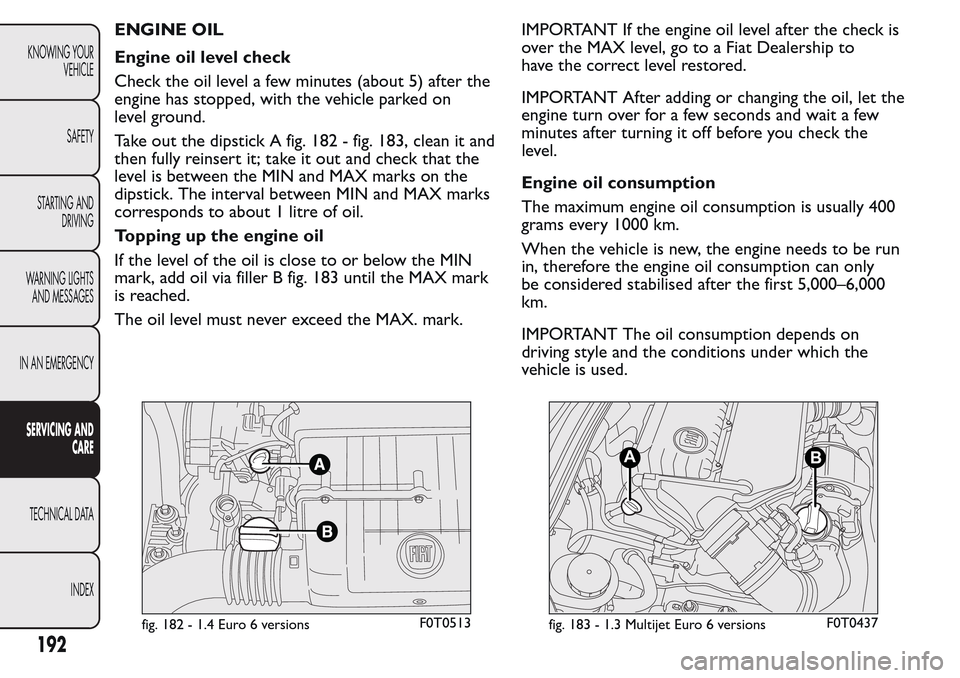
ENGINE OIL
Engine oil level check
Check the oil level a few minutes (about 5) after the
engine has stopped, with the vehicle parked on
level ground.
Take out the dipstick A fig. 182 - fig. 183, clean it and
then fully reinsert it; take it out and check that the
level is between the MIN and MAX marks on the
dipstick. The interval between MIN and MAX marks
corresponds to about 1 litre of oil.
Topping up the engine oil
If the level of the oil is close to or below the MIN
mark, add oil via filler B fig. 183 until the MAX mark
is reached.
The oil level must never exceed the MAX. mark.IMPORTANT If the engine oil level after the check is
over the MAX level, go to a Fiat Dealership to
have the correct level restored.
IMPORTANT After adding or changing the oil, let the
engine turn over for a few seconds and wait a few
minutes after turning it off before you check the
level.
Engine oil consumption
The maximum engine oil consumption is usually 400
grams every 1000 km.
When the vehicle is new, the engine needs to be run
in, therefore the engine oil consumption can only
be considered stabilised after the first 5,000–6,000
km.
IMPORTANT The oil consumption depends on
driving style and the conditions under which the
vehicle is used.
fig. 182 - 1.4 Euro 6 versionsF0T0513
AB
fig. 183 - 1.3 Multijet Euro 6 versionsF0T0437
192
KNOWING YOUR
VEHICLE
SAFETY
STARTING AND
DRIVING
WARNING LIGHTS
AND MESSAGES
IN AN EMERGENCY
SERVICING AND
CARE
TECHNICAL DATA
INDEX
Page 197 of 260
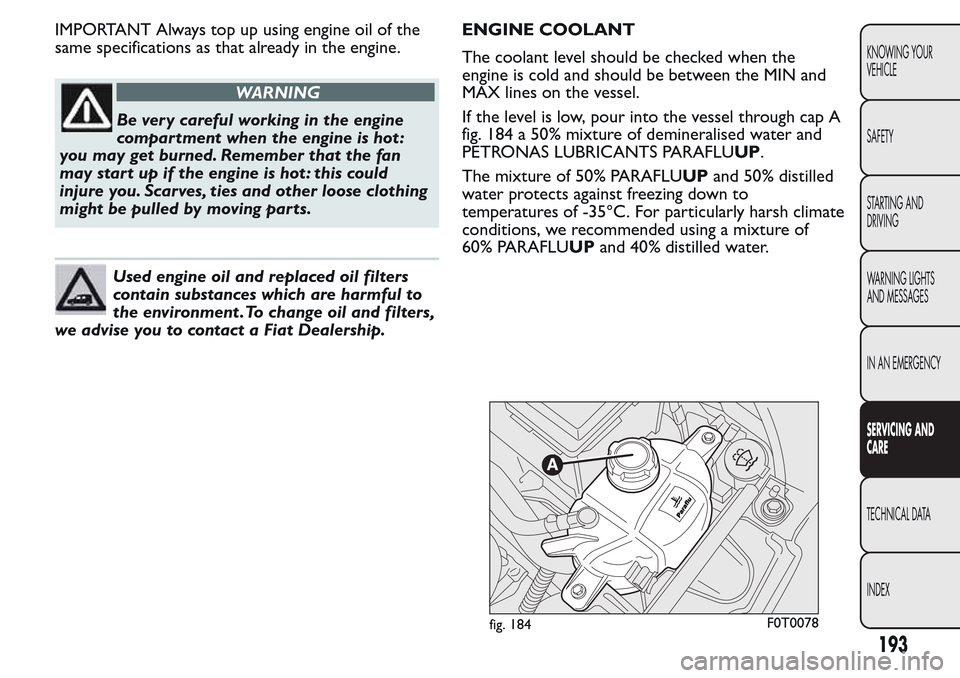
IMPORTANT Always top up using engine oil of the
same specifications as that already in the engine.
WARNING
Be very careful working in the engine
compartment when the engine is hot :
you may get burned. Remember that the fan
may start up if the engine is hot : this could
injure you. Scarves, ties and other loose clothing
might be pulled by moving parts.
Used engine oil and replaced oil filters
contain substances which are harmful to
the environment .To change oil and filters,
we advise you to contact a Fiat Dealership.ENGINE COOLANT
The coolant level should be checked when the
engine is cold and should be between the MIN and
MAX lines on the vessel.
If the level is low, pour into the vessel through cap A
fig. 184 a 50% mixture of demineralised water and
PETRONAS LUBRICANTS PARAFLUUP.
The mixture of 50% PARAFLUUPand 50% distilled
water protects against freezing down to
temperatures of -35°C. For particularly harsh climate
conditions, we recommended using a mixture of
60% PARAFLUUPand 40% distilled water.
fig. 184F0T0078
193
KNOWING YOUR
VEHICLE
SAFETY
STARTING AND
DRIVING
WARNING LIGHTS
AND MESSAGES
IN AN EMERGENCY
SERVICING AND
CARE
TECHNICAL DATA
INDEX
Page 198 of 260
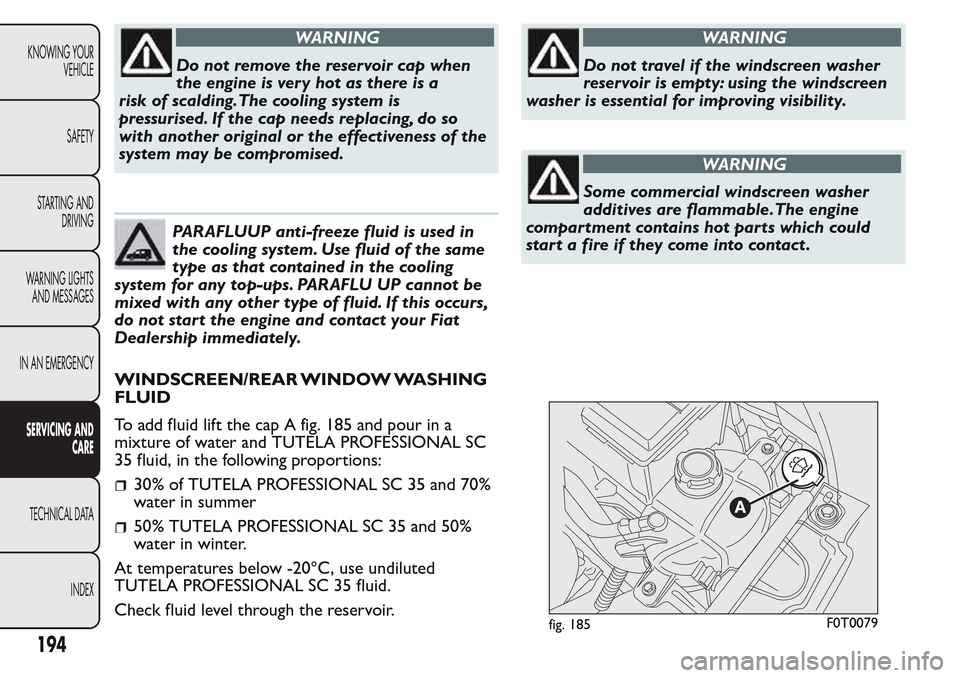
WARNING
Do not remove the reservoir cap when
the engine is very hot as there is a
risk of scalding.The cooling system is
pressurised. If the cap needs replacing, do so
with another original or the effectiveness of the
system may be compromised.
PARAFLUUP anti-freeze fluid is used in
the cooling system. Use fluid of the same
type as that contained in the cooling
system for any top-ups. PARAFLU UP cannot be
mixed with any other type of fluid. If this occurs,
do not start the engine and contact your Fiat
Dealership immediately.
WINDSCREEN/REAR WINDOW WASHING
FLUID
To add fluid lift the cap A fig. 185 and pour in a
mixture of water and TUTELA PROFESSIONAL SC
35 fluid, in the following proportions:
30% of TUTELA PROFESSIONAL SC 35 and 70%
water in summer
50% TUTELA PROFESSIONAL SC 35 and 50%
water in winter.
At temperatures below -20°C, use undiluted
TUTELA PROFESSIONAL SC 35 fluid.
Check fluid level through the reservoir.
WARNING
Do not travel if the windscreen washer
reservoir is empty: using the windscreen
washer is essential for improving visibility.
WARNING
Some commercial windscreen washer
additives are flammable.The engine
compartment contains hot parts which could
star t a fire if they come into contact .
fig. 185F0T0079
194
KNOWING YOUR
VEHICLE
SAFETY
STARTING AND
DRIVING
WARNING LIGHTS
AND MESSAGES
IN AN EMERGENCY
SERVICING AND
CARE
TECHNICAL DATA
INDEX
Page 199 of 260
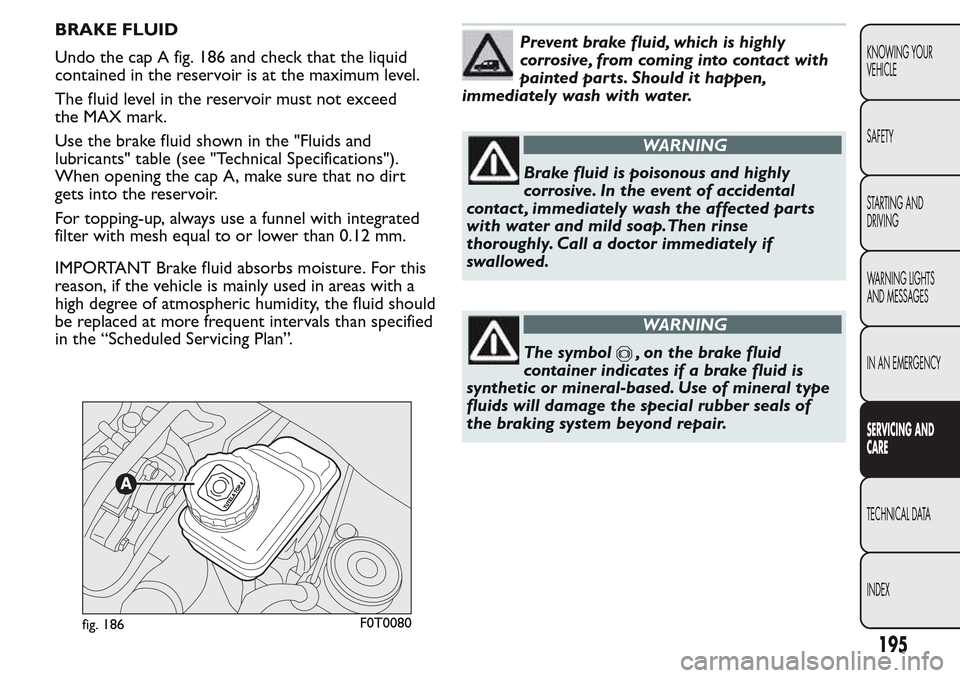
BRAKE FLUID
Undo the cap A fig. 186 and check that the liquid
contained in the reservoir is at the maximum level.
The fluid level in the reservoir must not exceed
the MAX mark.
Use the brake fluid shown in the "Fluids and
lubricants" table (see "Technical Specifications").
When opening the cap A, make sure that no dirt
gets into the reservoir.
For topping-up, always use a funnel with integrated
filter with mesh equal to or lower than 0.12 mm.
IMPORTANT Brake fluid absorbs moisture. For this
reason, if the vehicle is mainly used in areas with a
high degree of atmospheric humidity, the fluid should
be replaced at more frequent intervals than specified
in the “Scheduled Servicing Plan”.Prevent brake fluid, which is highly
corrosive, from coming into contact with
painted parts. Should it happen,
immediately wash with water.
WARNING
Brake fluid is poisonous and highly
corrosive. In the event of accidental
contact , immediately wash the affected parts
with water and mild soap.Then rinse
thoroughly. Call a doctor immediately if
swallowed.
WARNING
The symbol, on the brake fluid
container indicates if a brake fluid is
synthetic or mineralbased. Use of mineral type
fluids will damage the special rubber seals of
the braking system beyond repair.
fig. 186F0T0080
195
KNOWING YOUR
VEHICLE
SAFETY
STARTING AND
DRIVING
WARNING LIGHTS
AND MESSAGES
IN AN EMERGENCY
SERVICING AND
CARE
TECHNICAL DATA
INDEX
Page 200 of 260
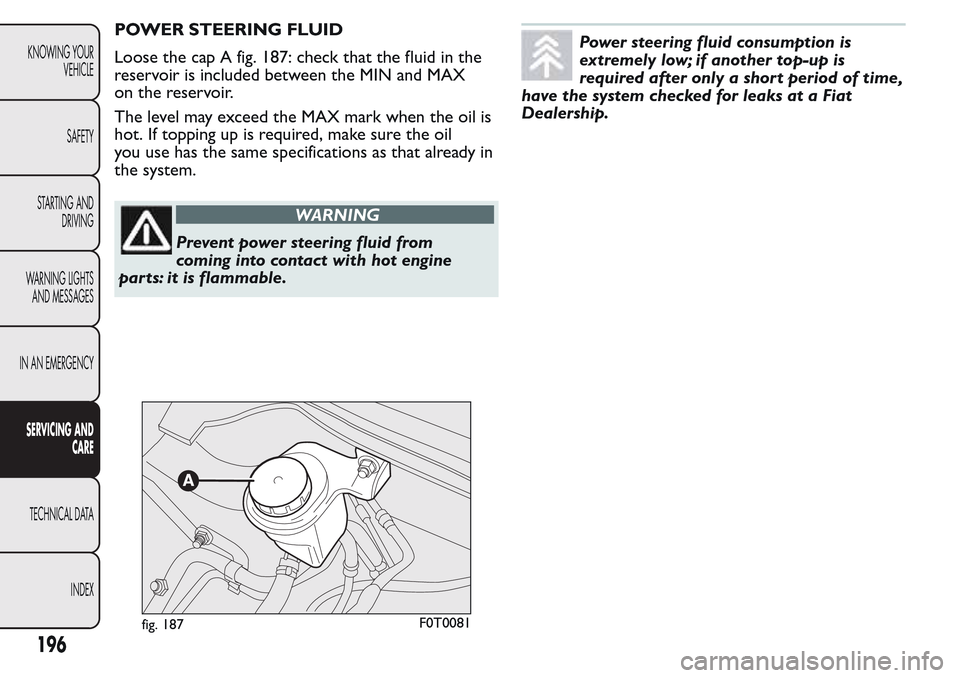
POWER STEERING FLUID
Loose the cap A fig. 187: check that the fluid in the
reservoir is included between the MIN and MAX
on the reservoir.
The level may exceed the MAX mark when the oil is
hot. If topping up is required, make sure the oil
you use has the same specifications as that already in
the system.
WARNING
Prevent power steering fluid from
coming into contact with hot engine
parts: it is flammable.
Power steering fluid consumption is
extremely low; if another top-up is
required after only a short period of time,
have the system checked for leaks at a Fiat
Dealership.
fig. 187F0T0081
196
KNOWING YOUR
VEHICLE
SAFETY
STARTING AND
DRIVING
WARNING LIGHTS
AND MESSAGES
IN AN EMERGENCY
SERVICING AND
CARE
TECHNICAL DATA
INDEX
Page 201 of 260
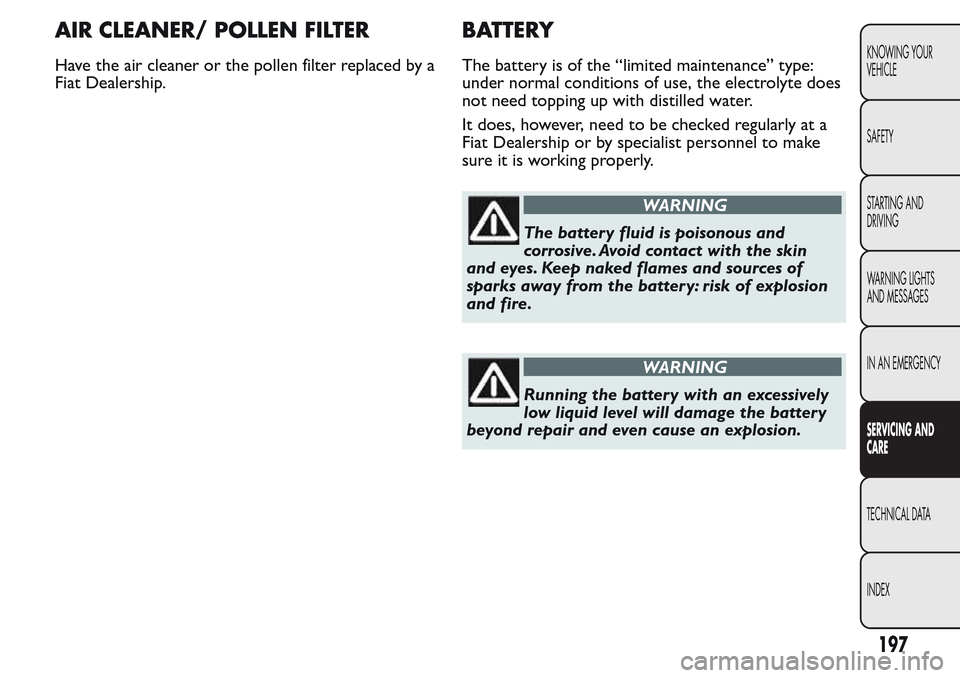
AIR CLEANER/ POLLEN FILTER
Have the air cleaner or the pollen filter replaced by a
Fiat Dealership.
BATTERY
The battery is of the “limited maintenance” type:
under normal conditions of use, the electrolyte does
not need topping up with distilled water.
It does, however, need to be checked regularly at a
Fiat Dealership or by specialist personnel to make
sure it is working properly.
WARNING
The battery fluid is poisonous and
corrosive. Avoid contact with the skin
and eyes. Keep naked flames and sources of
sparks away from the battery: risk of explosion
and fire.
WARNING
Running the battery with an excessively
low liquid level will damage the battery
beyond repair and even cause an explosion.
197
KNOWING YOUR
VEHICLE
SAFETY
STARTING AND
DRIVING
WARNING LIGHTS
AND MESSAGES
IN AN EMERGENCY
SERVICING AND
CARE
TECHNICAL DATA
INDEX
Page 202 of 260
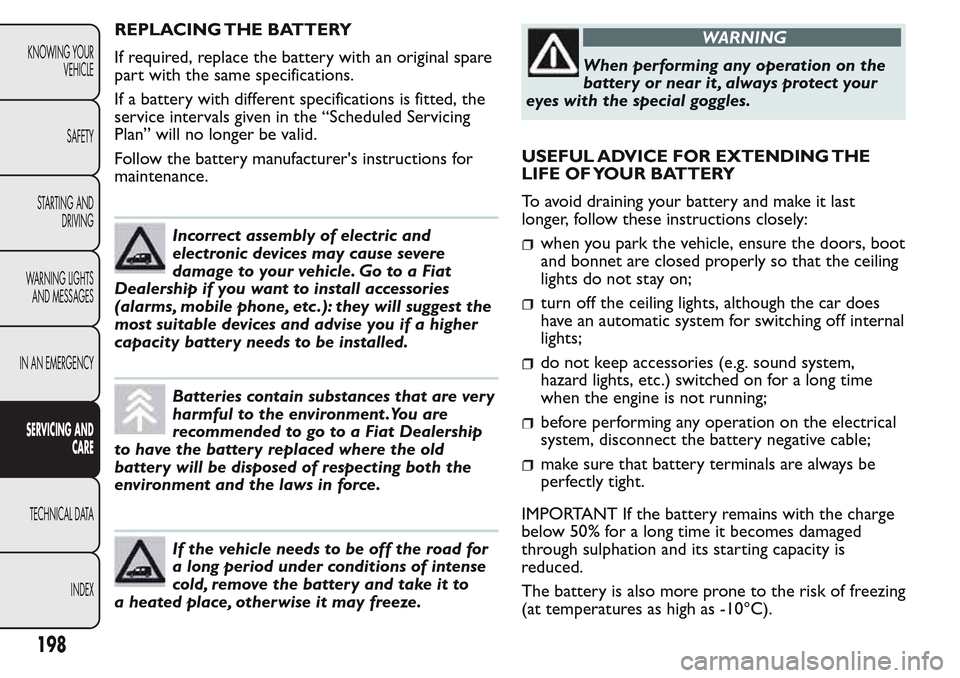
REPLACING THE BATTERY
If required, replace the battery with an original spare
part with the same specifications.
If a battery with different specifications is fitted, the
service intervals given in the “Scheduled Servicing
Plan” will no longer be valid.
Follow the battery manufacturer's instructions for
maintenance.
Incorrect assembly of electric and
electronic devices may cause severe
damage to your vehicle. Go to a Fiat
Dealership if you want to install accessories
(alarms, mobile phone, etc .): they will suggest the
most suitable devices and advise you if a higher
capacity batter y needs to be installed.
Batteries contain substances that are very
harmful to the environment .You are
recommended to go to a Fiat Dealership
to have the batter y replaced where the old
battery will be disposed of respecting both the
environment and the laws in force.
If the vehicle needs to be off the road for
a long period under conditions of intense
cold, remove the battery and take it to
a heated place, otherwise it may freeze.
WARNING
When performing any operation on the
battery or near it , always protect your
eyes with the special goggles.
USEFUL ADVICE FOR EXTENDING THE
LIFE OF YOUR BATTERY
To avoid draining your battery and make it last
longer, follow these instructions closely:
when you park the vehicle, ensure the doors, boot
and bonnet are closed properly so that the ceiling
lights do not stay on;
turn off the ceiling lights, although the car does
have an automatic system for switching off internal
lights;
do not keep accessories (e.g. sound system,
hazard lights, etc.) switched on for a long time
when the engine is not running;
before performing any operation on the electrical
system, disconnect the battery negative cable;
make sure that battery terminals are always be
perfectly tight.
IMPORTANT If the battery remains with the charge
below 50% for a long time it becomes damaged
through sulphation and its starting capacity is
reduced.
The battery is also more prone to the risk of freezing
(at temperatures as high as -10°C).
198
KNOWING YOUR
VEHICLE
SAFETY
STARTING AND
DRIVING
WARNING LIGHTS
AND MESSAGES
IN AN EMERGENCY
SERVICING AND
CARE
TECHNICAL DATA
INDEX
Page 203 of 260
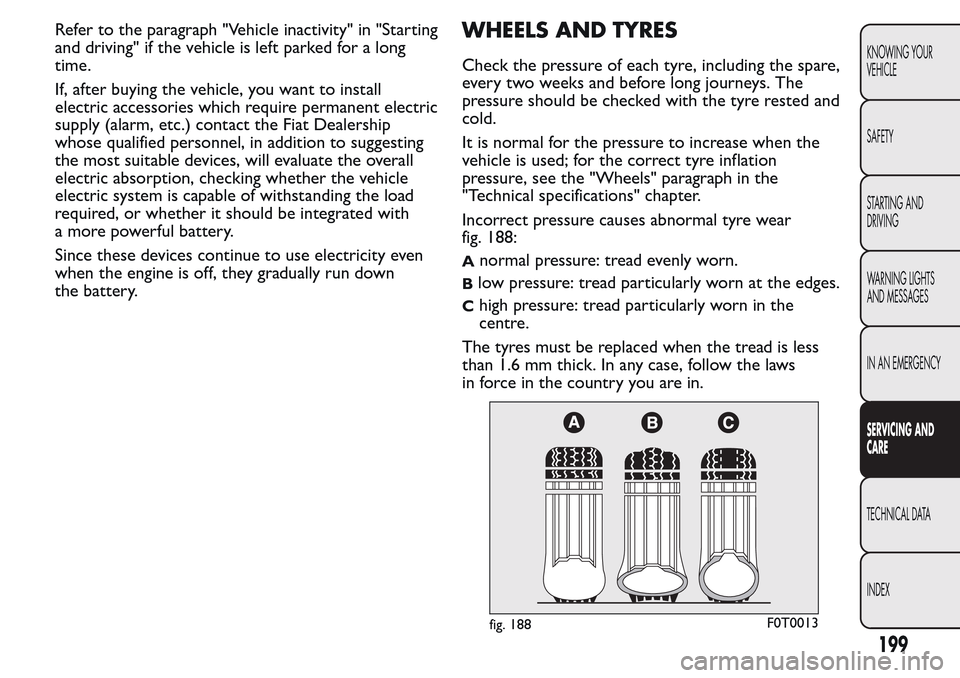
Refer to the paragraph "Vehicle inactivity" in "Starting
and driving" if the vehicle is left parked for a long
time.
If, after buying the vehicle, you want to install
electric accessories which require permanent electric
supply (alarm, etc.) contact the Fiat Dealership
whose qualified personnel, in addition to suggesting
the most suitable devices, will evaluate the overall
electric absorption, checking whether the vehicle
electric system is capable of withstanding the load
required, or whether it should be integrated with
a more powerful battery.
Since these devices continue to use electricity even
when the engine is off, they gradually run down
the battery.WHEELS AND TYRES
Check the pressure of each tyre, including the spare,
every two weeks and before long journeys. The
pressure should be checked with the tyre rested and
cold.
It is normal for the pressure to increase when the
vehicle is used; for the correct tyre inflation
pressure, see the "Wheels" paragraph in the
"Technical specifications" chapter.
Incorrect pressure causes abnormal tyre wear
fig. 188:
Anormal pressure: tread evenly worn.
Blow pressure: tread particularly worn at the edges.
Chigh pressure: tread particularly worn in the
centre.
The tyres must be replaced when the tread is less
than 1.6 mm thick. In any case, follow the laws
in force in the country you are in.
fig. 188F0T0013
199
KNOWING YOUR
VEHICLE
SAFETY
STARTING AND
DRIVING
WARNING LIGHTS
AND MESSAGES
IN AN EMERGENCY
SERVICING AND
CARE
TECHNICAL DATA
INDEX
Page 204 of 260
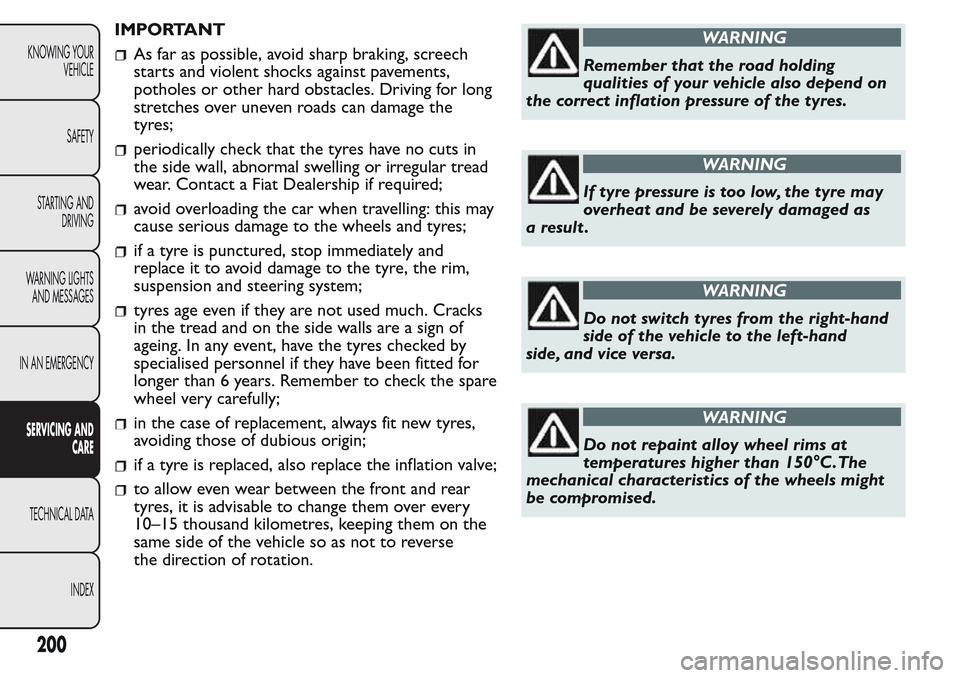
IMPORTANT
As far as possible, avoid sharp braking, screech
starts and violent shocks against pavements,
potholes or other hard obstacles. Driving for long
stretches over uneven roads can damage the
tyres;
periodically check that the tyres have no cuts in
the side wall, abnormal swelling or irregular tread
wear. Contact a Fiat Dealership if required;
avoid overloading the car when travelling: this may
cause serious damage to the wheels and tyres;
if a tyre is punctured, stop immediately and
replace it to avoid damage to the tyre, the rim,
suspension and steering system;
tyres age even if they are not used much. Cracks
in the tread and on the side walls are a sign of
ageing. In any event, have the tyres checked by
specialised personnel if they have been fitted for
longer than 6 years. Remember to check the spare
wheel very carefully;
in the case of replacement, always fit new tyres,
avoiding those of dubious origin;
if a tyre is replaced, also replace the inflation valve;
to allow even wear between the front and rear
tyres, it is advisable to change them over every
10–15 thousand kilometres, keeping them on the
same side of the vehicle so as not to reverse
the direction of rotation.
WARNING
Remember that the road holding
qualities of your vehicle also depend on
the correct inflation pressure of the tyres.
WARNING
If tyre pressure is too low, the tyre may
overheat and be severely damaged as
a result .
WARNING
Do not switch tyres from the righthand
side of the vehicle to the lefthand
side, and vice versa.
WARNING
Do not repaint alloy wheel rims at
temperatures higher than 150°C.The
mechanical characteristics of the wheels might
be compromised.
200
KNOWING YOUR
VEHICLE
SAFETY
STARTING AND
DRIVING
WARNING LIGHTS
AND MESSAGES
IN AN EMERGENCY
SERVICING AND
CARE
TECHNICAL DATA
INDEX
Page 205 of 260
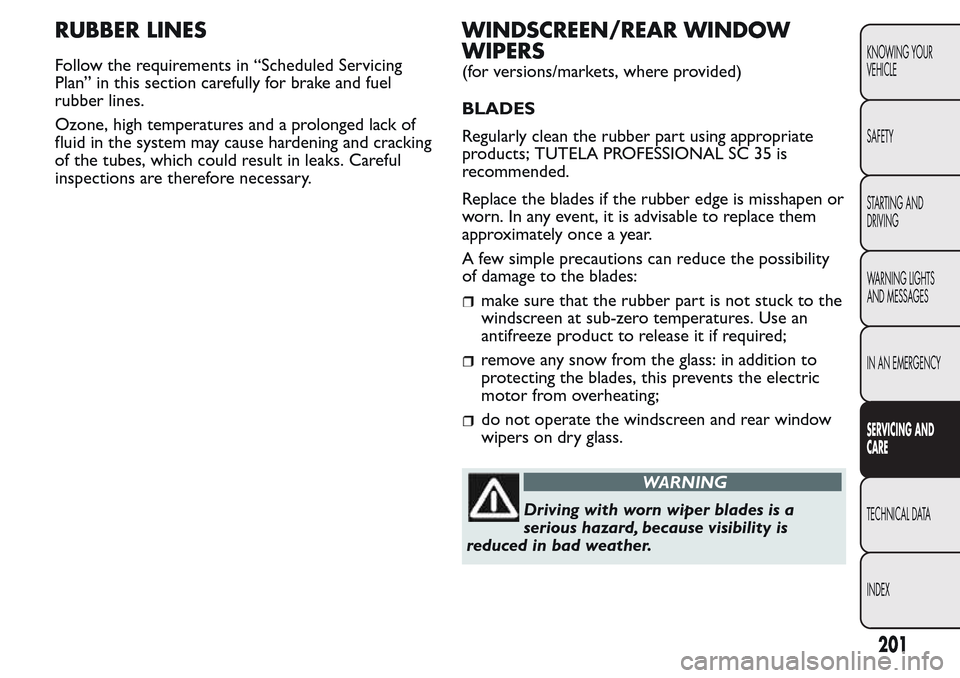
RUBBER LINES
Follow the requirements in “Scheduled Servicing
Plan” in this section carefully for brake and fuel
rubber lines.
Ozone, high temperatures and a prolonged lack of
fluid in the system may cause hardening and cracking
of the tubes, which could result in leaks. Careful
inspections are therefore necessary.
WINDSCREEN/REAR WINDOW
WIPERS
(for versions/markets, where provided)
BLADES
Regularly clean the rubber part using appropriate
products; TUTELA PROFESSIONAL SC 35 is
recommended.
Replace the blades if the rubber edge is misshapen or
worn. In any event, it is advisable to replace them
approximately once a year.
A few simple precautions can reduce the possibility
of damage to the blades:
make sure that the rubber part is not stuck to the
windscreen at sub-zero temperatures. Use an
antifreeze product to release it if required;
remove any snow from the glass: in addition to
protecting the blades, this prevents the electric
motor from overheating;
do not operate the windscreen and rear window
wipers on dry glass.
WARNING
Driving with worn wiper blades is a
serious hazard, because visibility is
reduced in bad weather.
201
KNOWING YOUR
VEHICLE
SAFETY
STARTING AND
DRIVING
WARNING LIGHTS
AND MESSAGES
IN AN EMERGENCY
SERVICING AND
CARE
TECHNICAL DATA
INDEX